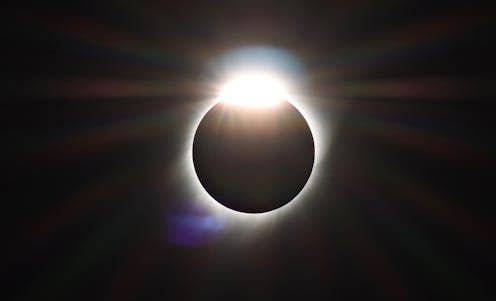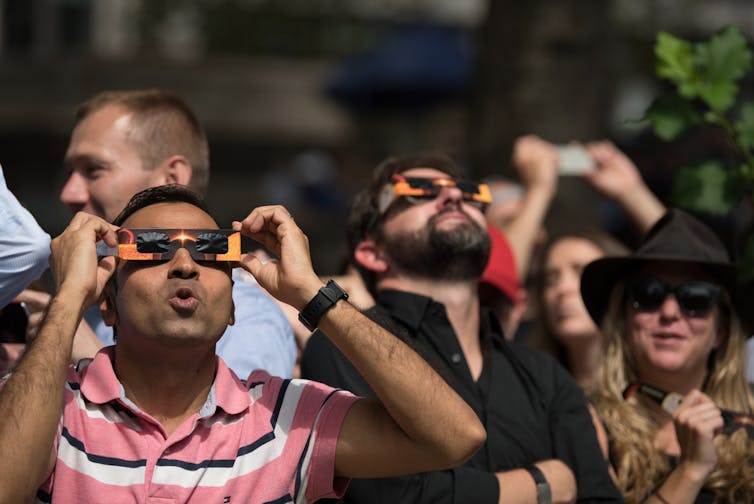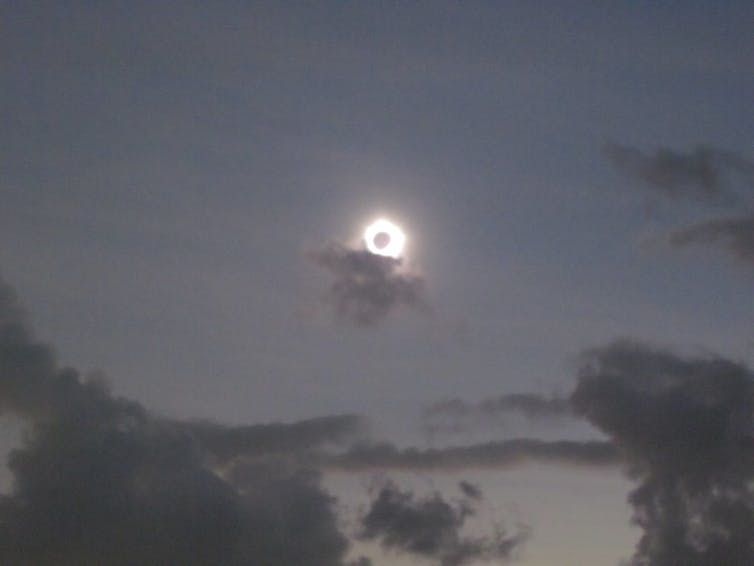Source: The Conversation (Au and NZ) – By Nick Lomb, Honorary Professor, Centre for Astrophysics, University of Southern Queensland

This week, eclipse chasers will be visiting the small town of Exmouth, at the tip of North West Cape in Western Australia. Weather permitting, they are coming to see one of nature’s greatest sights – a total eclipse of the Sun on Thursday April 20.
Whether staying at hotels, resorts or camping sites, many would have made travel arrangements a year or more in advance. But don’t be too disappointed if you can’t be there; other opportunities to see total eclipses are coming up in the next few years. Here’s what you need to know.
A fully immersive experience
A total solar eclipse occurs on those rare occasions when the Moon lines up with the Sun and passes in front of it from our vantage point here on Earth. The bright disc of the Sun is entirely hidden for a short period – seconds or minutes. During this time, called the totality, eclipse watchers will see a dark hole in the sky where the Sun had been, surrounded by a faint glow – our star’s corona.
Read more:
Explainer: what is a solar eclipse?
This is what eclipse chasers seek to witness. The string of locations where a total eclipse will be visible to observers is called the “path of totality”. People will often travel thousands of kilometres to be in the right place at the right time. They are not only treated to the magnificent sight of the corona, but get a fully immersive experience.
The sky rapidly darkens, the temperature drops, birds stop twittering and animals start going to sleep. The gathered observers, whether from your own group or from distant countries, are united in the experience.

Nick Lomb, Author provided
An addictive hobby
There are two warnings associated with total solar eclipses. One is that chasing them is addictive. Often people who have seen their first eclipse immediately want to start planning to see their second.
I can vouch for this personally – after watching my first total eclipse on December 4 2002 from the Woomera Rocket Range, I became most keen to observe another. Seeing the corona surrounding the dark Sun come into view was an awe-inspiring experience, heightened by the fascinating location and the elation of fellow observers. My next eclipse was on August 1 2008 at an even more interesting location – a beach on the shore of the Novosibirsk Reservoir in Siberia; and most recently, I watched the Far North Queensland eclipse on November 14 2012.
The other warning is this: the only time it’s safe to look directly at the Sun is during the brief period of totality. All other times, during the partial phases before and after, it is necessary to take precautions.
For this, special eclipse glasses are available from planetariums, public observatories, amateur astronomy groups and astronomy stores. Just make sure the glasses have the CE European standard mark.
Taking photographs is safe, though only during totality unless you have the appropriate filters. A tripod is essential, as the corona is faint and you will need long exposures. Seasoned eclipse observers arrive at eclipse sites loaded with professional-grade cameras and telephoto lenses. But if it’s your first time, it’s probably better to just watch and absorb the event, rather than try photographing it.

Mihai O Coman/Shutterstock
Plan ahead and stay mobile
After this week’s eclipse in Australia, the next total solar eclipse will be visible on April 8 2024 from the United States and Mexico. After passing through Mexico, the path of totality sweeps across the United States from Texas to Maine, before moving to parts of Canada.
There are many potential viewing spots along the path. However, before picking a site, it’s important to study the “climate report” for the eclipse. This grants the best chance of avoiding the eclipse watcher’s greatest enemy – clouds.
However, even with the best advance planning, last-minute clouds are possible. Seasoned observers try to stay mobile, so that if the weather forecast is bad for their location, they can move to another location to avoid the clouds.
The US total solar eclipse will be followed on August 12 2026 with one where the path of totality passes over Spain and Iceland. Then there will be one on August 2 2027, visible from Egypt and Saudi Arabia.
An upcoming eclipse of greatest interest to Australians is the total solar eclipse on July 22 2028, for which the path of totality passes from WA through the Northern Territory to New South Wales towns such as Bourke, Dubbo and Mudgee before reaching Sydney. It is rare for a major city to be in the path of totality, and the five million people of Sydney will get a once-in-a-lifetime opportunity to view a total solar eclipse from their homes or backyards.

Nick Lomb, Author provided
Of course, like at any other eclipse, clouds are a possibility, so keep a lookout for weather reports closer to the date. Before eclipse day, look at the forecasts from the Bureau of Meteorology and specialised astronomy websites.
As mentioned, for serious eclipse observers, mobility before a total eclipse is essential. For example, at the November 14 2012 eclipse in Far North Queensland, a Sydney Observatory group made a successful last minute dash inland to avoid the forecast poor weather.
Clouds, however, are not all bad. For the same eclipse, I was at Palm Cove Beach and fortunately, the clouds parted just at the start of totality. The excitement involved made for a fantastic and unique experience.
If you are not at North West Cape this week and want to experience the wonders of a future total solar eclipse, you may want to start planning now.
Read more:
A century ago, Australia was ground zero for eclipse-watchers – and helped prove Einstein right
![]()
Nick Lomb does not work for, consult, own shares in or receive funding from any company or organisation that would benefit from this article, and has disclosed no relevant affiliations beyond their academic appointment.
– ref. Want to see a total solar eclipse? Here’s how to plan for it – and how to set your expectations in case of clouds – https://theconversation.com/want-to-see-a-total-solar-eclipse-heres-how-to-plan-for-it-and-how-to-set-your-expectations-in-case-of-clouds-200540







